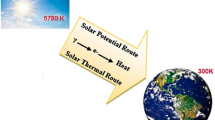Abstract
Performance analysis of thin-film solar modules has been done using the pyramid texturing technique. To change the geometry of the surface of the solar cell through surface texturing technique, it increases the effective area of thin-film module. Significant improvement has been found by inserting a random pyramid structure. TCAD and PvSyst software is used to design and development of surface texturing and temperature-dependent loss minimization. Efficiency improvement of 3% has been achieved using this noble approach.
Access this chapter
Tax calculation will be finalised at checkout
Purchases are for personal use only
Similar content being viewed by others
References
A. Chaïb, M. Kesraoui, E. Kechadi, PV panel positioning using a robot manipulator, in 3rd International on Renewable and Sustainable Energy Conference (IRSEC). IEEE (2015)
S. Singh, M. Fozdar, A. Almutairi, S. Alyami, H. Malik, Strategic bidding in the presence of renewable sources for optimizing the profit of the power suppliers. IEEE Access. https://doi.org/10.1109/ACCESS.2021.3078288
A.K. Yadav, et al., Soft computing in condition monitoring and diagnostics of electrical and mechanical systems, in Part of the Advances in Intelligent Systems and Computing, vol. 1096, p. 496 (Springer Nature, 2020). https://doi.org/10.1007/978-981-15-1532-3
K. Masuko et al., Achievement of more than 25% conversion efficiency with crystalline silicon hetero-junction solar cell. IEEE J. Photovoltaic’s 4(6), 1433–1435 (2014)
S. Singh, M. Fozdar, Double-sided bidding strategy for power suppliers and large buyers with amalgamation of wind and solar based generation in a modern energy market. IET Gener. Transm. Distrib. 14(6), 1031–1041 (2020)
S. Singh, M. Fozdar, Supplier’s strategic bidding for profit maximization with solar power in a day-ahead market, in Advances in Machine Learning and Computational Intelligence. Algorithms for Intelligent Systems (Springer, Singapore, 2021). https://doi.org/10.1007/978-981-15-5243-4_74
https://www.lens.org/lens/search/scholar/analysis?q=Performance%20analysis%20of%20PV%20module
https://www.lens.org/lens/search/scholar/analysis?q=pyramid%20surface%20texturing%20Approach
S. Ahsan et al., Design and cost analysis of 1 kW photovoltaic system based on actual performance in Indian scenario. Perspect. Sci. 8, 642–644 (2016)
A. Iqbal, et al., Meta Heuristic and Evolutionary Computation: Algorithms and Applications, in Part of the Studies in Computational Intelligence, vol. 916, p. 849 (Springer Nature, 2020), 978-981-15-7571-6. https://doi.org/10.1007/978-981-15-7571-6
O. Singh, S.K. Gupta, A review on recent Mppt techniques for photovoltaic system, in 2018 IEEMA Engineer Infinite Conference (eTechNxT), 2018, pp. 1–6. https://doi.org/10.1109/ETECHNXT.2018.8385315
N. Kumar, P. Yadav, S.S. Chandel, Comparative analysis of four different solar photovoltaic technologies, in 2015 International Conference on Energy Economics and Environment (ICEEE), 2015, pp. 1–6. https://doi.org/10.1109/EnergyEconomics.2015.7235077
V. Sharma, A. Kumar, O.S. Sastry, S.S. Chandel, Performance assessment of different solar photovoltaic technologies under similar outdoor conditions. Energy 58, 511–518 (2013). ISSN 0360-5442
I.J. Lee, U. Paik, J.G. Park, Solar cell implemented with silicon nanowires on pyramid-texture silicon surface. Solar Energy 91, 256–262 (2013). ISSN 0038-092X
A. Iqbal, et al., Renewable Power for Sustainable Growth, in Part of the Lecture Notes in Electrical Engineering, vol. 723. Springer Nature, 2021, p. 805. 978-981-33-4080-0. https://doi.org/10.1007/978-981-33-4080-0
X. Tian, et al.: Pyramid size control and its effects on the performance of silicon heterojunction solar cells, in China Semiconductor Technology International Conference, Shanghai (2015)
S. Srivastava, et al., Applications of Artificial Intelligence Techniques in Engineering, vol. 1, in Part of the Advances in Intelligent Systems and Computing, vol. 698, p. 643 (Springer Nature, 2018). 978-981-13-1819-1. https://doi.org/10.1007/978-981-13-1819-1
W.S. Bennett, N.L. Niraj, B.F. Simeon, P.W. Thomas, Pyramidal surface textures for light trapping and antireflection in perovskite-on-silicon tandem solar cells. Opt. Express 22, A1422–A1430 (2014)
E. Tarigan, Djuwari, F.D. Kartikasari, Techno-economic simulation of a grid-connected PV system design as specifically applied to residential in Surabaya, Indonesia. Energy Procedia 65, 90–99 (2015)
Y.M. Irwan et al., Stand-alone photovoltaic (SAPV) system assessment using PVSYST software. Energy Procedia 79, 596–603 (2015)
D. Kler, Y. Goswami, K.P.S. Rana, K. Vineet, A novel approach to parameter estimation of photovolataic using hybridized optimizer. J.: Energy Convers. Manage. 187(1), 486–511 (2019)
A.A. Mona, E. Mahieddine, Performance analysis of rooftop PV systems in Abu Dhabi. Energy Procedia 42, 689–697 (2013)
M.U. Hasan, S. Saha, M.E. Haque, Techno-economic analysis and performance evaluation of rooftop solar PV systems using actual data in Australian context, in 2020 IEEE Industry Applications Society Annual Meeting, 2020, pp. 1–8. https://doi.org/10.1109/IAS44978.2020.9334784
Author information
Authors and Affiliations
Editor information
Editors and Affiliations
Rights and permissions
Copyright information
© 2022 The Author(s), under exclusive license to Springer Nature Singapore Pte Ltd.
About this chapter
Cite this chapter
Bansal, R.K., Singh, S., Singh, A.K., Waseem Ahmad, M. (2022). Performance Analysis of PV Module Using Pyramid Surface Texturing Approach. In: Malik, H., Ahmad, M.W., Kothari, D. (eds) Intelligent Data Analytics for Power and Energy Systems. Lecture Notes in Electrical Engineering, vol 802. Springer, Singapore. https://doi.org/10.1007/978-981-16-6081-8_24
Download citation
DOI: https://doi.org/10.1007/978-981-16-6081-8_24
Published:
Publisher Name: Springer, Singapore
Print ISBN: 978-981-16-6080-1
Online ISBN: 978-981-16-6081-8
eBook Packages: Intelligent Technologies and RoboticsIntelligent Technologies and Robotics (R0)




